英语新课标整理版
新课标人教版四年级上册英语知识点整理
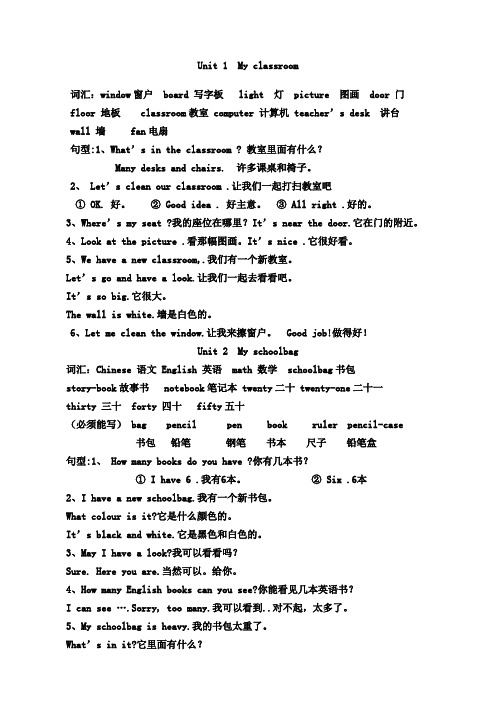
Unit 1 My classroom词汇:window窗户 board 写字板 light 灯 picture 图画 door 门floor 地板 classroom教室 computer 计算机teacher’s desk 讲台wall 墙 fan电扇句型:1、What’s in the classroom ? 教室里面有什么?Many desks and chairs. 许多课桌和椅子。
2、Let’s clean our classroom .让我们一起打扫教室吧① OK. 好。
② Good idea . 好主意。
③ All right .好的。
3、Where’s my seat ?我的座位在哪里?It’s near the door.它在门的附近。
4、Look at the picture .看那幅图画。
It’s nice .它很好看。
5、We have a new classroom,.我们有一个新教室。
Let’s go and have a look.让我们一起去看看吧。
It’s so big.它很大。
The wall is white.墙是白色的。
6、Let me clean the window.让我来擦窗户。
Good job!做得好!Unit 2 My schoolbag词汇:Chinese 语文 English 英语 math 数学 schoolbag书包story-book故事书 notebook笔记本 twenty二十 twenty-one二十一thirty 三十 forty 四十 fifty五十(必须能写) bag pencil pen book ruler pencil-case书包铅笔钢笔书本尺子铅笔盒句型:1、 How many books do you have ?你有几本书?① I have 6 .我有6本。
② Six .6本2、I have a new schoolbag.我有一个新书包。
(完整版)最新小学英语新课程标准
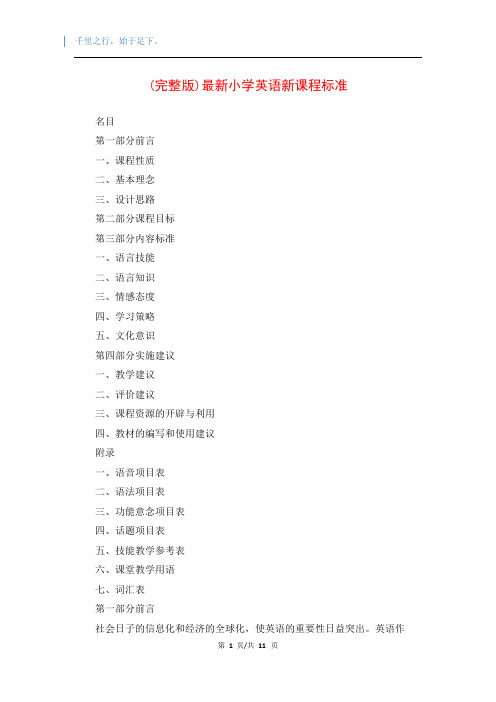
(完整版)最新小学英语新课程标准名目第一部分前言一、课程性质二、基本理念三、设计思路第二部分课程目标第三部分内容标准一、语言技能二、语言知识三、情感态度四、学习策略五、文化意识第四部分实施建议一、教学建议二、评价建议三、课程资源的开辟与利用四、教材的编写和使用建议附录一、语音项目表二、语法项目表三、功能意念项目表四、话题项目表五、技能教学参考表六、课堂教学用语七、词汇表第一部分前言社会日子的信息化和经济的全球化,使英语的重要性日益突出。
英语作许多国家在基础教育进展战略中,都把英语教育作为公民素养教育的重要组成部分,并将其摆在突出的地位。
改革开放以来,我国的英语教育规模别断扩大,教育教学取得了显著的成就。
但是,英语教育的现状尚别能习惯我国经济建设和社会进展的需要,与时代进展的要求还存在差距。
此次英语课程改革的重点算是要改变英语课程过分重视语法和词汇知识的说解与传授、忽视对学生实际语言运用能力的培养的倾向,强调课程从学生的学习兴趣。
日子经验和认知水平动身,倡导体验、实践、参与、合作与交流的学习方式和任务型的教学途径,进展学生的综合语言运用能力,使语言学习的过程成为学生形成积极的情感态度、主动思维和大胆实践、提高跨文化意识和形成自主学习能力的过程。
一、课程性质外语是基础教育时期的必修课程,英语是外语课程中的要紧语种之一。
英语课程的学习,既是学生经过英语学习和实践活动,逐步掌握英语知识和技能,提高语言实际运用能力的过程;又是他们磨砺意志、陶冶情操、拓展视野、丰富日子记忆、开辟思维能力、进展个性和提高人文素质的过程。
基础教育时期英语课程的任务是:激发和培养学生学习英语的兴趣,使学生树立自信心,养成良好的学习适应和形成有效的学习策略,进展自主学习的能力和合作精神;使学生掌握一定的英语基础知识和听、讲、读、写技能,形成一定的综合语言运用能力;培养学生的观看、经历、思维、想象能力和创新精神;帮助学生了解世界和中西方文化的差异,拓展视野,培养爱国主义精神,形成健康的人一辈子观,为他们的终身学习和进展打下良好的基础。
高中英语新课程标准解读(可复制版)

高中英语新课程标准解读随着信息时代的到来和国际交往的日益频繁,英语作为国际通用语的地位日趋重要。
社会的发展对高中毕业生的英语素养(特别是语言使用水平)提出了更高和更多样化的要求。
为了能让高中生更好的迎接升学、就业以及培养终身学习水平,教育部重新确定了高中《英语课程标准》。
新标准从以知识为本的教育理念转向以学生发展为本的教育理念。
与原有的标准的相比,主要有以下几方面的变化。
一、多维度、综合型教学目标高中阶段在发展学生英语基本语言使用水平的同时,着重发展学生收集与处理信息的水平、分析问题和解决问题的水平以及思维与表达的水平,形成跨文化交际的意识和水平,为学生的进一步学习和发展创造必要的条件。
新课标从五个不同的维度提出了不同水平层级的具体目标。
五个维度是指语言技能、语言知识、情感态度、学习策略和文化意识。
综合语言使用水平的形成建立在语言技能、语言知识、情感态度、学习策略和文化意识等素养整合发展的基础上。
语言技能和语言知识是语言使用水平的基础;情感态度是影响学生学习和发展的重要因素;学习策略是提升学习效率、发展自主学习水平的先决条件;文化意识是得体使用语言的保障。
二、学分制、分级式和选择性的课程结构原标准对课程结构没有太重视。
原课程结构过于统一,过于强调学科本位,科目过多和缺乏整合。
而新标准表达了课程结构的均衡性、综合性和选择性。
为使学生在普遍达到基本要求的前提下实现有个性的发展,新课标设置了不同水平的要求,在开设必修课的同时,设置丰富多样的选修课。
必修课的目的是使学生获得基本的英语语言水平,形成积极向上的学习态度、灵活多样的学习策略以及跨文化交际的意识和水平,为终身学习奠定基础。
而选修课是为了满足学生的就业、升学和个人兴趣和发展的需要。
高中英语课程由必修,选修I、选修II 三类课程构成:必修课程(6学分)为全体学生必须修习的课程,旨在构建英语学科核心核心素养的共同基础,使所有学生必须达到英语学业质量水平二的要求,满足高中毕业基本要求。
小学英语新课程标准【最新修订版】
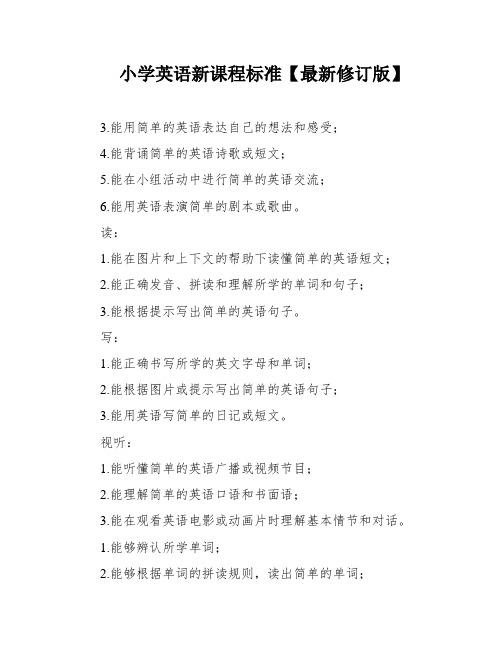
小学英语新课程标准【最新修订版】3.能用简单的英语表达自己的想法和感受;4.能背诵简单的英语诗歌或短文;5.能在小组活动中进行简单的英语交流;6.能用英语表演简单的剧本或歌曲。
读:1.能在图片和上下文的帮助下读懂简单的英语短文;2.能正确发音、拼读和理解所学的单词和句子;3.能根据提示写出简单的英语句子。
写:1.能正确书写所学的英文字母和单词;2.能根据图片或提示写出简单的英语句子;3.能用英语写简单的日记或短文。
视听:1.能听懂简单的英语广播或视频节目;2.能理解简单的英语口语和书面语;3.能在观看英语电影或动画片时理解基本情节和对话。
1.能够辨认所学单词;2.能够根据单词的拼读规则,读出简单的单词;3.能够理解教材中简短的要求或指令;4.能够理解贺卡等简单信息的含义;5.能够通过图片理解简单的故事或小短文,并养成按意群阅读的惯;6.能够正确地朗读所学故事或短文。
1.能够模仿范例写句子;2.能够写出简单的问候语;3.能够根据要求为图片、实物等写出简短的标题或描述;4.能够正确使用大小写字母和标点符号。
1.能够用简单的英语参与游戏;2.能够在教师的帮助下表演小故事或童话剧;3.能够表演30-40首歌谣或简单的诗歌(含一级要求);4.能够演唱30-40首英文歌曲(含一级要求);5.能够理解英文动画片和程度相当的英语教学节目,每学年不少于10小时(平均每周不少于20-25分钟)。
一、教学建议:1.面向全体学生,为学生全面发展和终身发展奠定基础;2.关注学生的情感,营造宽松、民主、和谐的教学氛围;3.倡导“任务型”教学途径,培养学生综合语言运用能力;4.加强对学生研究策略的指导,为他们终身研究奠定基础;5.拓展学生的文化视野,发展他们跨文化交际的意识和能力;6.利用现代教育技术,拓宽学生研究和运用英语的渠道;7.组织生动活泼的课外活动,促进学生的英语研究;8.不断更新知识结构,适应现代社会对英语课程的要求;9.遵循高频率原则的课时安排,保证教学质量和效果。
2024小学英语新课标及解读-1英文版

2024小学英语新课标及解读-1英文版2024 Primary School English New Curriculum Standards and Interpretation The 2024 Primary School English New Curriculum Standards have been introduced to enhance the quality of English education in primary schools. The new standards focus on improving students' English language proficiency through a more interactive and practical approach.The curriculum emphasizes the importance of developing students' listening, speaking, reading, and writing skills. It also includes components that encourage critical thinking, creativity, and cultural awareness.Teachers are encouraged to use a variety of teaching methods, such as group activities, role-playing, and multimedia tools, to engage students and make learning more enjoyable. The goal is to create a stimulating learning environment that motivates students to actively participate in lessons.The new curriculum also places a strong emphasis on integrating technology into English language learning. Teachers are encouraged to use online resources, educational apps, and interactive whiteboards to enhance students' learning experience.Overall, the 2024 Primary School English New Curriculum Standards aim to equip students with the necessary skills to communicate effectively in English and to develop a deeper understanding and appreciation of the language and culture. It is a step towards creating a more dynamic and engaging English learning environment for primary school students.。
2024更新版高中英语教育新课程标准教育部部编版
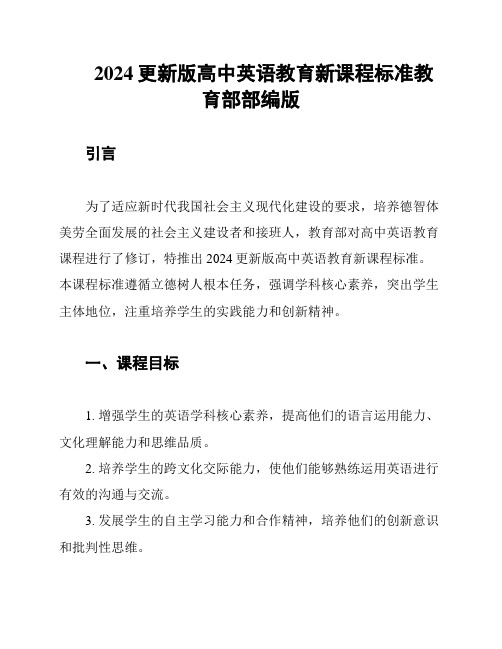
2024更新版高中英语教育新课程标准教育部部编版引言为了适应新时代我国社会主义现代化建设的要求,培养德智体美劳全面发展的社会主义建设者和接班人,教育部对高中英语教育课程进行了修订,特推出2024更新版高中英语教育新课程标准。
本课程标准遵循立德树人根本任务,强调学科核心素养,突出学生主体地位,注重培养学生的实践能力和创新精神。
一、课程目标1. 增强学生的英语学科核心素养,提高他们的语言运用能力、文化理解能力和思维品质。
2. 培养学生的跨文化交际能力,使他们能够熟练运用英语进行有效的沟通与交流。
3. 发展学生的自主学习能力和合作精神,培养他们的创新意识和批判性思维。
4. 帮助学生了解世界多元文化,拓宽国际视野,增强民族自豪感和文化自信心。
二、课程内容1. 语言知识:包括语音、词汇、语法、功能项目和话题等,注重培养学生的语言运用能力。
2. 文化背景:涵盖英语国家的文化、历史、社会等方面的知识,帮助学生理解西方文化,提高跨文化交际能力。
3. 技能训练:听说读写四大技能的综合训练,以及相应的策略运用,提高学生的语言实际运用能力。
4. 任务型教学:通过完成各种真实的任务,培养学生的实践能力和创新精神,使他们在实践中学会学习、学会合作、学会生存。
三、课程实施1. 教学方法:采用任务型教学、合作学习和探究学习等方法,充分发挥学生的主体作用。
2. 教学手段:充分利用多媒体、网络等现代教育技术手段,提高教学效果和学生的学习兴趣。
3. 评价方式:注重形成性评价和终结性评价相结合,全面、多元地评价学生的学科核心素养。
4. 课程资源:开发和利用各种课程资源,丰富教学内容,提高学生的学习体验。
四、课程安排1. 课时安排:高中英语课程每周安排3-4课时,共计240课时。
2. 课程结构:分为必修课程、选择性必修课程和选修课程,满足不同学生的学习需求。
3. 学段安排:分为三个学段,每个学段40课时,每个学段结束后进行阶段性评价。
2024高考英语真题【全国新课标I卷】(整理版)

绝密★启用前2024年普通高等学校招生全国统一考试(新课标I卷)英语姓名____________ 准考证号____________全卷共12页,满分150分,考试时间120分钟。
考生注意:1. 答题前,请务必将自己的姓名、准考证号用黑色字迹的签字笔或钢笔分别填写在试题卷和答题纸规定的位置上。
2. 答题时,请按照答题纸上“注意事项”的要求,在答题纸相应的位置上规范作答,在本试题卷上的作答一律无效。
第一部分听力(共两节,满分30分)做题时,先将答案标在试卷上。
录音内容结束后,你将有两分钟的时间将试卷上的答案转涂到答题纸上。
第一节(共5小题;每小题1.5分,满分7.5分)听下面5段对话。
每段对话后有一个小题,从题中所给的A、B、C三个选项中选出最佳选项。
听完每段对话后,你都有10秒钟的时间来回答有关小题和阅读下一小题。
每段对话仅读一遍。
例:How much is the shirt?A. £19.15.B. £9.18.C. £9.15.答案是C。
1. What is Kate doing?A. Boarding a flight.B. Arranging a trip.C. Seeing a friend off.2. What are the speakers talking about?A. A pop star.B. An old song.C. A radio program.3. What will the speakers do today?A. Go to an art show.B. Meet the man’s aunt.C. Eat out with Mark.4. What does the man want to do?A. Cancel an order.B. Ask for a receipt.C. Reschedule a delivery.5. When will the next train to Bedford leave?A. At 9:45.B. At 10:15.C. At 11:00.第二节(共15小题;每小题1.5分,满分22.5分)听下面5段对话或独白。
高中英语课程标准_新课标_英文版
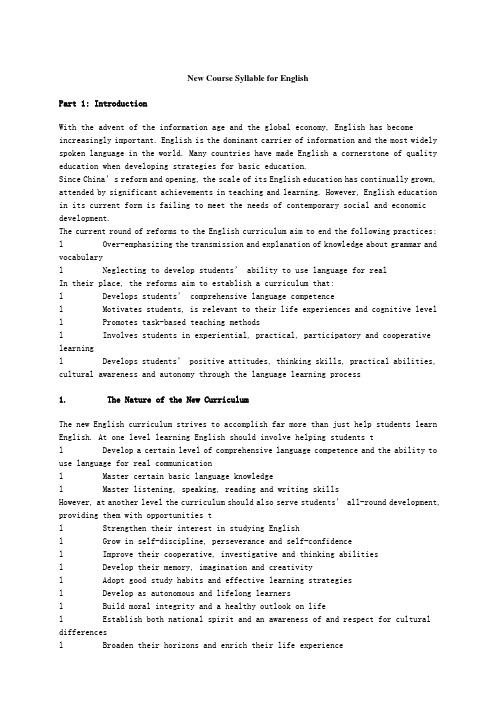
New Course Syllable for EnglishPart 1: IntroductionWith the advent of the information age and the global economy, English has become increasingly important. English is the dominant carrier of information and the most widely spoken language in the world. Many countries have made English a cornerstone of quality education when developing strategies for basic education.Since China’s reform and opening, the scale of its English education has continually grown, attended by significant achievements in teaching and learning. However, English education in its current form is failing to meet the needs of contemporary social and economic development.The current round of reforms to the English curriculum aim to end the following practices: l Over-emphasizing the transmission and explanation of knowledge about grammar and vocabularyl Neglecting to develop students’ ability to use language for realIn their place, the reforms aim to establish a curriculum that:l Develops students’ comprehensive l anguage competencel Motivates students, is relevant to their life experiences and cognitive level l Promotes task-based teaching methodsl Involves students in experiential, practical, participatory and cooperative learningl Develops students’ positive attitudes, thinking skills, practical abilities, cultural awareness and autonomy through the language learning process1. The Nature of the New CurriculumThe new English curriculum strives to accomplish far more than just help students learn English. At one level learning English should involve helping students tl Develop a certain level of comprehensive language competence and the ability to use language for real communicationl Master certain basic language knowledgel Master listening, speaking, reading and writing skillsHowever, at another level the curriculum should also serve students’ all-round development, providing them with opportunities tl Strengthen their interest in studying Englishl Grow in self-discipline, perseverance and self-confidencel Improve their cooperative, investigative and thinking abilitiesl Develop their memory, imagination and creativityl Adopt good study habits and effective learning strategiesl Develop as autonomous and lifelong learnersl Build moral integrity and a healthy outlook on lifel Establish both national spirit and an awareness of and respect for cultural differencesl Broaden their horizons and enrich their life experiencel Take part in cultural lifel Develop as individuals2. Basic Principles of the New Curriculum2.1The curriculum promotes quality education (as opposed to exam-orientated education) and the all-round development of the studentsTo promote quality education particular attention must be paid tl Valuing each student’s feelingsl Stimulating students’ interest in studying Englishl Helping students gain a sense of achievement and self-confidenceThe curriculum must go beyond developing students’ comprehensive language competence to include areas such as:l Improving students’ ability to contribute to cultural and social lifel Developing students’ practical abilitiesl Fostering students’ creativity2.2The curriculum objectives are holistic and flexible.The fundamental aim of the new English curriculum is to develop students’ comprehensive language competence. This aim is broken down into five general objectives. These objectives are then divided into nine ability levels with descriptors provided for each level. The five general objectives are:1. Language Skills2. Language Knowledge3. Attitudes to Learning4. Learning Strategies5. Cultural AwarenessThis design allows students to progress systematically through each level whilst meeting the full range of the curriculum’s demands.2.3Students are put at the centre of the curriculum and individual differences are respected Students’ must be at the heart of the new curricul um. For example, their developmental needs must be the central consideration when developing:l Curriculum objectivesl The teaching and learning processl The assessment processl Teaching and learning resourcesWhen implementing the curriculum each student must be allowed to develop individually under the guidance of the teacher:2.4The curriculum promotes activity-based methods, experiential and participatory learning The curriculum promotes task-based learning whereby, under the guidance of the teacher, the students gain a sense of achievement by reaching the goals of the task. Task completion will involve the following types of learning:l Sensoryl Experientiall ‘Hands on’/practicall Participatoryl CooperativeIn order to improve their ability to use language for real communication, students should also be able tl Adjust their learning strategies and control their emotionsl Form positive attitudes towards learning2.5The curriculum recognizes the important role of formative assessment in promoting student’ developmentThe assessment system should combine formative with summative assessment. The purposes of assessment should be tl Promote students’ comprehensive language competencel Encourage and motivate studentsl Help students become more autonomous learnersl Benefit students’ healthy personal developmentl Give teachers useful feedback from which to develop teaching and learningl Inform the ongoing development and perfection of the English curriculum Formative assessment should be an important part of the English teaching and learning process with a particular emphasis on:l Encouraging students’ active participation in learningl Improving stu dents’ self-confidenceSummative assessment should focus on:l Testing students’ integrated language skillsl Testing students’ ability to use language2.6The curriculum expands the range of learning resources and opportunities available The curriculum should strive to use and develop resources whose content is:l Realisticl Close to the students’ livesl Contemporaryl Healthyl Rich and variedActive use should be made of:l Audio visual materiall Print medial The InternetStudents should be encouraged to take responsibility for finding, using and developing learning resources themselves.3. The Curriculum DesignThe curriculum follows the international practice of dividing the general objectives into different ability levels. When designing these nine levels consideration was given to the following:l The nature of language developmentl The different needs of different age groupsl The needs of different ethnic groups and areasl The economic imbalances that exist in ChinaThe aim is to have designed a system that is holistic and flexible.The correspondence between the level system and the grade system is shown in the followingDiagram 1: The Levels and the GradesPart 2: Introduction to the General ObjectivesThe fundamental aim of the new curriculum is to develop students’ comprehensive language competence. This comprehensive language competence is achieved through the five general objectives as shown in the following diagram:Diagram 3: Comparison of the Old and New Curriculumsl Language skills and knowledge form the basis of comprehensive language competence l The students’ attitudes to learning strongly influence their learning and developmentl Successful learning strategies improve the effectiveness of students’ learning l Cultural awareness ensures students use language appropriatelyThe overall descriptors for comprehensive language competence (i.e. a combination of all five general objectives) for Levels 1 to 9 are presented below:Table 1: The Overall Descriptors for Comprehensive Language CompetencePart 3: The General Objectives in DetailDetailed descriptors for Levels 2 and 5 of each of the five general objectives are presented in the following tables. Please refer to the translation of the senior English curriculum (available from the VSO Programme Office) for Level 6 – 9 descriptors.Table 2: Level Descriptors for Language Skills ObjectiveN.B. The original includes Language Skills descriptors for Levels 1,3,4,6,7,8 and 9Table 3: Level Descriptors for Language Knowledge ObjectiveTable 5: Level Descriptors for Learning Strategies ObjectiveTable 6: Level Descriptors for Cultural AwarenessPart 4: Guidelines for Implementation1. Suggestions for Teaching and Learning1.1 Lay the groundwork for students’ all-round and lifelong developmentTeaching and learning should meet the diverse needs of all students, ensuring the healthy development of their mind and body. In particular the teacher should pay attention to the following:l Encourage students to use English bravely, taking a lenient attitude towards mistakes they make during the learning process.l Provide students with ample opportunities to collaborate with others and to become autonomous learners.l Give students plenty of space for self-development.l Encourage students to develop their language skills in an integrated way through experiential, practical, cooperative and inquiry-based learning.l Create conditions that allow students to explore questions they are personally interested in and solve problems by themselves.1.2 Create a relaxed, democratic and harmonious learning environmentPositive attitudes are an essential condition for effective learning. Negative attitudes can not only reduce the effectiveness of study but also adversely affect students’ long-term development. In particular, teachers should heed the following:l Respect each individual student, actively encouraging everyone to try and safeguarding their self-esteem and enthusiasm.l Integrate students’ English education with their emotional education. Develop cooperative spirit by organizing learning activities that let students work together, help each other and experience group recognition and achievement.l Pay particular attention to introverted students or weak learners, trying to give them as many language practice opportunities as possible.l Establish a friendly and democratic channel of communication between students and teacher, frequently reflecting on the learning process and results together, and offering mutual help and support.1.3 Use task-based learning methods to promote students comprehensive language competenceTeachers should try to adopt task-based learning methods as much as possible. Teachers should creatively design learning activities that are relevant to the students’ real lives, according to the overall curriculum objectives and content. Teachers should engage students’ interest in the activity and organize them effectively so that they participate actively and complete the tasks, learning and using English through thinking, carrying out surveys, discussing, communicating and cooperating. Attention should be paid to the following points when designing tasks:l Activities must have clear and achievable aims and objectives.l Activities must be relevant to students’ life experie nces and interests; the content and style should be as true to life as possible.l Activities must benefit the development of students’ language knowledge, language skills and ability to use language for real communication.l Activities should be of a cross-curricular nature, promoting the integrated development of students’ thinking and imagination, aesthetic and artistic sense, cooperative and creative spirit.l Activities should make students gather, process and use information, using English to communicate with others in order to develop their ability to use English to solve real problems.l Activities should not purely be limited to the classroom but also extend to out of school learning.N.B. In July 2005 VSO’s curriculum adviso r, Professor Zhang Lianzhong, mentioned that this section of the curriculum will be revised such that “we will take the TBL (Task-Based Learning) approach as one of the useful tools within the big box of Communicative Language Learning.”1.4. Provide increased guidance about learning strategiesHelping students to adopt good study habits and effective learning strategies is one of the important tasks of the new curriculum. Teachers should consciously give students guidance about learning strategies so that, through learning and using English, they are learning how to learn. To this end the teacher should observe the following:l Give students chances to establish their own study targets and the means of fulfilling these.l Help students to use inference, research and inquiry style methods to carry out their learning.l Develop students’ practical abilities and creative thinking by designing inquiry based activities.l Encourage students to use observation, discovery and induction to acquire language knowledge and grasp language functions.l Help students to carry out self-assessment during the learning process and adjust their own learning objectives and strategies appropriately according to the results. 1.4 Develop students’ aware ness of and ability in cross-cultural communication Language and culture are closely related, language being the main transmitter and carrier of culture. Teachers should work hard to help students achieve the following during the English learning process:l Understand foreign cultures, especially those of English speaking countries l Use English appropriatelyl Constantly broaden their cultural horizonsl Deepen their understanding of their own culturel Develop an awareness of and ability in cross-cultural communication1.5 Use modern teaching technology and expand learning opportunitiesIn order to increase the effectiveness of teaching and learning, teachers should make good use of modern technology, expand the range resources and opportunities through which students can learn, thereby modernizing learning ways. Conditions permitting, teachers should try tl Use audiovisual material and the Internet to enrich the learning content and form and improve outcomes.l Use computer and multi-media software to explore new teaching and learning methods and promote more individualized study.l Create conditions for students to study more independently through sensible use of a variety of learning resources, such as broadcasts, print media, libraries and the Internet.1.6 Organize lively and active extracurricular activities to promote students’ English learningTeachers should arrange a variety of extracurricular activities according to the students’ age and interests to help them expand their knowledge, broaden their horizons, strengthen their intellect and individuality and use their talents. The content and form of these carefully planned activities should be rich and varied. Suggestions include:l Recitalsl Songsl Story tellingl Speechesl Performancesl English cornerl English wall displaysl Cclass discussionsl ExhibitionsThe teacher should be good at leading these activities to maintain students’ interest and foster their creativity and initiative.1.7 Continue to develop professionallyTeachers should aim tl Familiarize themselves with the principles, objectives, content, teaching and learning methods, psychological theories and language learning research findings of this curriculuml Select and adjust English teaching and learning strategies according to their students’ psychological characteristicsl Develop their ability to organize and monitor activitiesl Use a variety of teaching skills and methods flexiblyl Master the use of modern educational technology, using it increasingly in their own continuing study and real classroom practicel Consciously deepen their knowledge of Chinese and foreign culturesl Actively and creatively explore which teaching and learning methods best suit their students’ needs, local conditions and the objectivesl Continuously reflect on their own practice, endeavouring to become a creative and research driven teacher1.8 Follow high frequency principles to ensure effective teaching and learningIn Grades 3-6 there should be a minimum of four teaching and learning periods per week, with shorter periods for the younger years. For Grades 5 and 6 classes should not exceed two periods in length. In order to ensure the effectiveness of teaching and learning, class sizes should not exceed 40 at primary level. Grades 7 –9 and senior school students should have a minimum of four lessons a week.N.B. The original provides five sample learning activities here that have not been translated.2. Suggestions for Assessment and EvaluationAssessment and evaluation is an important component of the new curriculum. Assessment should be carried out according to the requirements of the curriculum standards, focusing not only on the results but also the process of learning. The primary purposes of assessment are tl Let students continuously experience progress and success during the learning processl Let students know their own progress and build confidencel Promote all aspects of students’ comprehensive language competencel Provide the teacher with feedback on the teaching and learning processl Help the teacher reflect on their own teaching practice and adjust it accordingly l Help the teacher continuously improve the quality of their teachingl Provide the school with prompt feedback on the implementation of the curriculum l Help improve educational managementl Inform the ongoing development and perfection of the new English curriculum The assessment system should diversify both the subjects and forms of assessment. Assessment should focus on students’ comprehensive language competence, combining both formative assessment (concentrating on the study process) and summative assessment (concentrating on the learning outcomes).2.1 Ensure that students are the subjects (not objects) of assessmentStudents are at the centre of learning. The development of their comprehensive language competence should be the starting point for both teaching and learning and assessment. l Assessment should help students know their own progress, develop self-confidence, reflect on and adjust their own study process, thereby ensuring the continuous development of their language ability.l Teachers should help students carry out self-assessment.l Students should be active participants and collaborators in a variety of assessment activities.l Assessment should be an organic part of teaching and learning activities.l Assessment should help students to analyse their own successes and shortcomings, clarifying the direction in which they need to work.2.2 Make sure formative assessment plays a role in student developmentFormative assessment is an important component and driving element of teaching and learning. Formative assessment should check the students’ learning outcomes, attitudes and strategies during the everyday learning process. The purpose of formative assessment is to encourage students, help students adjust the learning process effectively, help students gain a sense of achievement, strengthen their self-confidence, and improve their cooperative spirit. Formative assessment helps students develop from passive objects of assessment to active participants in the assessment process. In order to let formative assessment become an organic part of the study process its important tl Establish an open and relaxed atmosphere for assessmentl Use both tests and other methodsl Use a combination of individual and small group assessmentl Encourage students, classmates, teachers and parents to collectively participate in assessment, thereby diversifying the subjects of assessmentFormative assessment can take many forms, such as:l Comparison and assessment of classroom learning activitiesl Self assessment of learning outcomesl A learning portfoliol Questionnairesl Interviewsl Feedback from parentsl Everyday quizzes and testsFormative assessment can be recorded in the form of descriptions, levels or marks. No matter what method is used, the role of assessment in encouraging learners must not be forgotten. According to the assessment results, teachers should give students individual feedback, ensuring their steady progress and encouraging them to reflect on and better themselves.2.3 Make sure assessment methods are varied and flexibleTeachers must select assessment methods suitable for the age of the students and the learning conditions. During formal assessment teachers should permit students to select assessment methods that suit their characteristics or strengths. If students get unsatisfactory results during a certain test they should be allowed to negotiate with the teacher to retake the test after sufficient preparation.2.4 Make sure assessment feedback is used to increase the effectiveness of teaching and learningThe teacher should ask themselves the following questions:l Does the assessment help promote autonomous learning and self-confidence?l Does the assessment reflect the students’ achievements?l Does the assessment reflect the teachers’ strengths and weaknesses?l Does the assessment reflect problems in the students’ learning process? Teachers should promptly adjust their teaching methods and plans according to assessment feedback.2.5 Summative assessment should focus on checking students’ comprehensive language competenceSummative assessment (such as end of term exams and graduation exams) is the main means of measuring the level of students’ comprehensive language competence. It also reflects the effectiveness of the teaching and learning process and is a major indicator of the schools’ quality in managing teaching and learning. Summative assessment must have the target of assessing students’ comprehensive language competence, striving to scientifically and comprehensively check students’ language level at the end of a particular stage of learning. The following should be observed:l Exams should include oral, listening and writing amongst other components in assessing students’ comprehensive language competence.l Listening tests must account for a minimum of twenty percent of termly, yearly and graduation exams.l Listening tests shoul d check students’ understanding and ability to gain information rather than asking them to distinguish between different pronunciations.l Writing exams should avoid testing knowledge of phonetics or grammar in isolation.l There should be an increase in questions that require students to use English in a specific language context.l Objective questions with a single correct answer should be reduced in favour of more subjective questions with several correct answers.l Exam results should not be publicly displayed nor students ranked in order of their results.2.6 Recognize the special characteristics of assessment for Grades 3 – 6The main purpose of assessment at primary level should be to encourage students’ interest and active participation in learning English. Assessment methods should be varied and choice should be offered. Formative assessment should be the main type, focusing mainly onstudents’ performance and ability to cooperate during a variety of everyday teaching and learning activities.l In Grades 3 and 4 end of term or end of year assessment should use assessment activities similar to normal teaching and learning activities. Through observing students’ behaviour and discussing with them teachers should assess their ability to use English to do things.l For end of term or year assessment in Grades 5 and 6 a combination of oral and written tests can be used. Oral tests should check students’ ability to use language to communicate about content close to their real lives. Written tests should focus on checking their listening and reading skills, using methods that are as active and lively as possible.2.7 Pay attention to the relationship between assessment and teaching and learning Pay attention to the proportion of teaching and learning time spent on assessment. Only carry out assessment that has useful results. Avoid over-elaborate and time-consuming assessment processes. Don’t let assessment become the sole end of teaching and learning.2.8 The assessment of each level should be founded on the general objectivesThe general objectives should be the basis for all assessment. Since the assessment of Level 2 will be organized by individual places and schools, formative assessment should be the main means. The same applies to all other levels apart from Levels 5 and 8, whose assessment is organized by national and provincial education bodies. Selection exams should unite the requirements of this curriculum with those of local conditions to establish suitable levels and test demands.N.B. Six examples of assessment documents are provide in the original. They are just listed here.Example 1: Self assessment questionnaire for Grade 7-9 students about learning strategies Includes statements such as:l I can concentrate during study.l During communication I use gestures and facial expressions to help express myself.l I often use associations to help study and remember new wordsStudents choose between ‘never’, ‘rarely’, ‘sometimes’, ‘often’ and ‘always’. Example 2: Assessment reference sheet for Grade 3-6 for English ‘playing, performing, watching, speaking and listening’Example 3: Formative assessment scheme for Grade 3-6 listening at Level 2Example 4: Guidelines for using student portfoliosPortfolios might include:l Some kind of baseline assessmentl A record of the students’ classroom performance – e.g. participation in role-plays, volunteering to read something aloud, etc.l Examples of the students’ best written homework, a s selected by themselves l Teachers’ and parents’ observations on the students’ study situationl Results of tests and quizzes marked by the teacher, student or students’ classmates, either as grades or written commentsl Students’ self-assessments and reflections on their own attitude, methods and outcomesExample 5: Guidelines for oral testsEnd of term or end of year oral tests should test students’ real ability to express themselves orally. Students can be tested in groups of two, three or four. According to a situation or topic (that might be presented through words or pictures), students discuss and communicate. Teachers should assess their oral expression, communicative ability and effectiveness. The following questions may be useful:l Is information coherent and easily expressed? (Students may make grammar and vocabulary mistakes that affect the accuracy but the basic information is still transmitted effectively.)l Are the pronunciation, intonation and rhythm natural? Can the speaker be understood?l Does the speaker use appropriate communication strategies, such as repetition, clarification, using expressions and gestures, to complete the activity successfully? Example 6: Reference sheet for the assessment of writing for Levels 3 – 8.3. Exploitation and Use of Curricular Resources4. The compilation of teaching materials and guidelines for their useN.B. A full translation of these final two sections is incorporated in the translation of the senior English curriculum available from the Programme Office.。
完整word版,高中英语新课标解读

高中英语新课标解读一、新课程标准产生的背景原有的高中课程总体上还是过分注重对语言知识的系统讲解,过分强调记忆的功能和机械的训练,缺乏对学生语言运用能力的培养,对学生的情感需求和自主学习能力的培养关注不够。
课程内容与学生的生活联系还不够紧密,与学生所学的其他学科知识的联系也需要加强。
教学中忽视对学生提取信息和处理信息能力的培养,忽视对学生分析问题、解决问题能力的培养,单一的、满堂灌的教学方法和被动的学习方式难以使学生形成听说读写的综合语言运用能力,难以发展学生的思维能力和分析问题、解决问题的能力。
高考外语科目近年来逐步在改革,从重语言知识转向重语言能力,加强了对学生听力和阅读能力培养的导向。
近年来,各地高中英语教学改革的要求越来越迫切。
有些地区和学校已经进行了多项教学改革实验并取得了令人瞩目的成果。
部分教师的教学观念和教学方法有了较大的转变。
在条件较好的高中,高中教师的业务水平、学校的教学条件、课程的资源都发生了很大的变化,学生的英语水平已有明显的提高。
现行的教材和教学大纲的要求已不能适应学生发展思维能力和语用能力的需要。
二、《新课程标准》的特点高中英语课程改革的目的是要使新世纪的每一位高中毕业生都具有基本的英语语言素养,也就是具备共同的语言能力基础,使他们不论是升学还是就业,都具有终身学习所必备的英语语言基础知识和基本技能,具有一定的自主学习的愿望和能力,具有初步的跨文化交际的意识和能力,这一共同的语言能力基础应该成为普通高中教育为每个学生未来发展所创设的平台和机会。
同时,高中课程还应在为每个学生打好共同语言能力的基础上,使他们能够按照个人的能力、潜力、特长与志趣,以及未来的职业倾向和长远发展的目标来学习适合自己的课程,学会规划自己的人生,做出自己的选择,从而使高中阶段的英语课程成为具有体现基础性学习、扩展性学习、提高性学习、个性化学习和自主性学习特点的课程,在学习的过程中,为每个学生的充分发展和表现提供机会和条件。
(2020年整理)小学英语新课程标准.doc
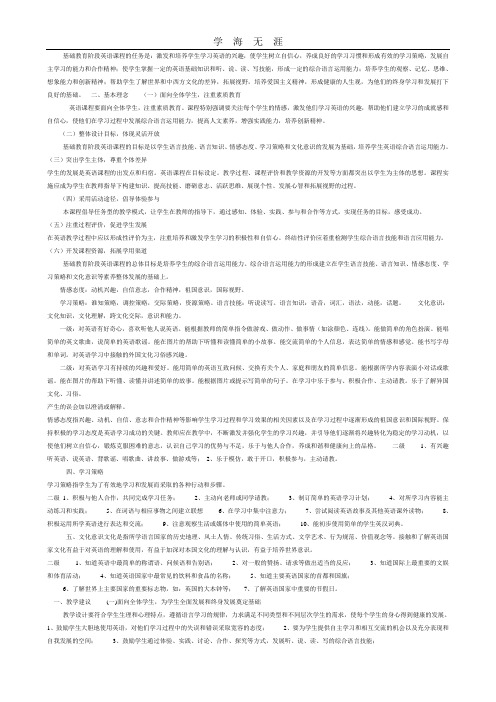
基础教育阶段英语课程的任务是:激发和培养学生学习英语的兴趣,使学生树立自信心,养成良好的学习习惯和形成有效的学习策略,发展自主学习的能力和合作精神;使学生掌握一定的英语基础知识和听、说、读、写技能,形成一定的综合语言运用能力;培养学生的观察、记忆、思维、想象能力和创新精神;帮助学生了解世界和中西方文化的差异,拓展视野,培养爱国主义精神,形成健康的人生观,为他们的终身学习和发展打下良好的基础。
二、基本理念(一)面向全体学生,注重素质教育英语课程要面向全体学生,注重素质教育。
课程特别强调要关注每个学生的情感,激发他们学习英语的兴趣,帮助他们建立学习的成就感和自信心,使他们在学习过程中发展综合语言运用能力,提高人文素养,增强实践能力,培养创新精神。
(二)整体设计目标,体现灵活开放基础教育阶段英语课程的目标是以学生语言技能、语言知识、情感态度、学习策略和文化意识的发展为基础,培养学生英语综合语言运用能力。
(三)突出学生主体,尊重个体差异学生的发展是英语课程的出发点和归宿。
英语课程在目标设定。
教学过程、课程评价和教学资源的开发等方面都突出以学生为主体的思想。
课程实施应成为学生在教师指导下构建知识、提高技能、磨砺意志、活跃思维、展现个性、发展心智和拓展视野的过程。
(四)采用活动途径,倡导体验参与本课程倡导任务型的教学模式,让学生在教师的指导下,通过感知、体验、实践、参与和合作等方式,实现任务的目标,感受成功。
(五)注重过程评价,促进学生发展在英语教学过程中应以形成性评价为主,注重培养和激发学生学习的积极性和自信心。
终结性评价应着重检测学生综合语言技能和语言应用能力。
(六)开发课程资源,拓展学用渠道基础教育阶段英语课程的总体目标是培养学生的综合语言运用能力。
综合语言运用能力的形成建立在学生语言技能、语言知识、情感态度、学习策略和文化意识等素养整体发展的基础上。
情感态度:动机兴趣,自信意志,合作精神,祖国意识,国际视野。
(完整版)人教版新课标高中英语各单元重点知识内容梳理
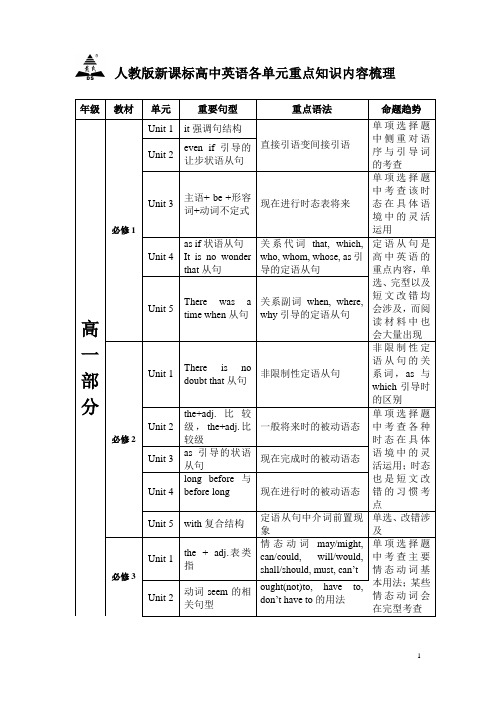
人教版新课标高中英语各单元重点知识内容梳理年级教材单元重要句型重点语法命题趋势高一部分必修1Unit 1 it强调句结构直接引语变间接引语单项选择题中侧重对语序与引导词的考查Unit 2even if引导的让步状语从句Unit 3主语+ be +形容词+动词不定式现在进行时态表将来单项选择题中考查该时态在具体语境中的灵活运用Unit 4as if状语从句It is no wonderthat从句关系代词that, which,who, whom, whose, as引导的定语从句定语从句是高中英语的重点内容,单选、完型以及短文改错均会涉及,而阅读材料中也会大量出现Unit 5There was atime when从句关系副词when, where,why引导的定语从句必修2Unit 1There is nodoubt that从句非限制性定语从句非限制性定语从句的关系词,as与which引导时的区别Unit 2the+adj.比较级,the+adj.比较级一般将来时的被动语态单项选择题中考查各种时态在具体语境中的灵活运用;时态也是短文改错的习惯考点Unit 3as引导的状语从句现在完成时的被动语态Unit 4long before与before long 现在进行时的被动语态Unit 5 with复合结构定语从句中介词前置现象单选、改错涉及必修3Unit 1the + adj.表类指情态动词may/might,can/could, will/would,shall/should, must, can’t单项选择题中考查主要情态动词基本用法;某些情态动词会在完型考查Unit 2动词seem的相关句型ought(not)to, have to,don’t have to的用法。
最新初中英语新课程标准(2020年整理).pptx

听 1. 能识别不同句式的语调,如陈述句,疑问句和指令等。 2. 能根据语调变化,判断句子意义的变化。 3. 能辨认歌谣中的韵律。 4. 能识别语段中句子间的联系。 5. 能听懂学习活动中连续的指令和问题,并做出适当反应。 6. 能听懂有关熟悉话题的语段。 7.能借助提示听懂教师讲述的故事。 说
1. 能根据语调和重音理解说话者的意图 2. 能听懂有关熟悉话题的谈话,并能从中提取信息和观点 3. 能借助语境克服生词障碍,理解大意 4. 能听懂接近正常语速的故事和记叙文,理解故事的因果关系 5. 能在听的过程中用适当的方式做出反应 6.能针对所听语段的内容记录简单信息 说
1. 能就简单的话题提供信息,表达简单的观点和意见,参与讨论 2. 能与他人沟通信息,合作完成任务
语音 1. 了解语音在语言学习中的意义 2. 了解英语语音包括发音,重音,连读。语调,节奏等内容 3. 在曰常生活会话中做到语音语调基本正确,自然流畅 4. 根据重音和语调的变化理解和表达不同的意图和态度 5.根据读音拼写单词和短语 词汇
6. 了解英语词汇包括单词,短语,习惯用语和固定搭配等形式 7. 理解和领悟词汇的基本含义以及在特定语境中的意义 8. 运用词汇描述事物,行为和特征,说明概念等 9. 学会使用 1500-1600 个的单词和 200-300 个习惯用语或固定搭配语法 10. 了解常用语言形式的基本结构和常用表意功能 11. 在实际运用中体会和领悟语言形式的表意功能 12. 理解和掌握描述人和物的表达方式 13. 理解和掌握描述具体事件和具体行为的发生,发展过程的表达方式 14.初步掌握描述时间,地点,方位的表达方式 6.理解掌握比较人,物体及事物的表达方式 功 能
8. 能在课堂活动中用简短的英语进行交际。 9. 能就熟悉的话题进行简单的交流。 10. 能在教师的指导下参与简单的游戏和角色扮演活动。 11.能利用所给提示(图片,幻灯片,实物,文字等)简单描述一件事情。 12. 能提供有关个人情况和个人经历的信息。 13. 能讲述简单的小故事。 14. 能背诵一定数量的英语小诗或歌谣,能唱一些英语歌曲。 15.能在上述口语活动中语音,语调基本正确。 读
初中英语新课程标准(2023年版)笔记

初中英语新课程标准(2023年版)笔记1. 课程目标- 强调培养学生的语言运用能力,包括听、说、读、写和翻译。
- 培养学生的跨文化交际能力,增进对不同文化的理解和尊重。
- 培养学生的综合运用语言能力,能够进行创造性思维和实践活动。
2. 课程内容- 语言知识:强调语法、词汇、句型等的研究与应用。
- 语言技能:注重听力、口语、阅读和写作技能的培养。
- 文化意识:通过研究英语国家的文化、风俗等,增进跨文化交际能力。
- 研究策略:教授学生有效的研究方法和策略,提高自主研究能力。
3. 教学方法- 任务型教学:通过设置具体的任务,激发学生研究的兴趣和动力。
- 合作研究:鼓励学生在小组中进行合作研究,促进交流和互动。
- 多媒体教学:利用多种媒体资源,提供生动、丰富的教学内容。
- 情景教学:通过情境设置,让学生在实际语言运用中研究和实践。
4. 评价方式- 综合评价:综合考察学生的听、说、读、写和翻译能力。
- 任务评价:根据学生完成的任务情况进行评价。
- 个别评价:针对学生的个别表现进行评价和指导。
5. 相关要求- 合理设计教学方案,根据学生的不同研究特点和需求进行个性化教学。
- 提供丰富的实践机会,让学生在实际运用中巩固所学知识。
- 鼓励使用多种资源和工具,培养学生的信息获取和处理能力。
- 注重培养学生的研究兴趣和研究策略,提高自主研究和创新能力。
总结:初中英语新课程标准(2023年版)旨在培养学生的语言运用能力、跨文化交际能力和综合运用语言能力。
课程内容包括语言知识、语言技能、文化意识和学习策略。
教学方法注重任务型教学、合作学习、多媒体教学和情景教学。
评价方式包括综合评价、任务评价和个别评价。
教学要求包括合理设计教学方案、提供实践机会、使用多种资源和工具,以及培养学生的学习兴趣和学习策略。
2024最新初中英语新课程标准教育部部编版

2024最新初中英语新课程标准教育部部编版引言为了适应21世纪全球化和社会发展的需要,培养具有创新精神和实践能力的社会主义建设者和接班人,教育部对初中英语课程进行了修订。
本课程标准依据我国《基础教育课程改革纲要(试行)》的精神,坚持立德树人,发展素质教育,强调语言学习的人文性和工具性统一,全面提高学生的英语核心素养。
一、课程目标1.1 知识与技能- 掌握英语的基础语音、词汇、语法知识。
- 学会使用英语进行有效的交流和沟通。
- 了解英语国家的文化背景,提高跨文化交际能力。
1.2 过程与方法- 通过听、说、读、写的实践活动,培养学生的语言运用能力。
- 运用探究、合作、交流等学习方法,提高学习效率。
1.3 情感态度与价值观- 培养学生的合作精神和社会责任感。
- 激发学生对英语学习的兴趣,树立正确的价值观。
二、课程内容2.1 主题与话题课程内容围绕人与自我、人与社会、人与自然三大主题展开,涵盖生活中的各种情境和话题。
2.2 语言技能听说读写四种技能均衡发展,注重实际语言运用能力的培养。
2.3 学习策略培养学生自主学习、合作学习和探究学习的能力。
2.4 文化意识增加英语国家文化知识的教学,提高学生的跨文化交际能力。
三、课程实施3.1 教学建议- 结合实际教学情况,创造性地使用教材,注重培养学生的实际语言运用能力。
- 运用现代教育技术手段,提高教学效果。
3.2 评价建议- 形成性评价与终结性评价相结合,注重学生的全面发展。
- 关注学生的学习过程,鼓励学生自主评价和互相评价。
3.3 教材编写建议- 教材应体现课程标准的各项要求,注重语言实践和跨文化交际能力的培养。
- 教材内容应贴近学生的生活实际,激发学生学习兴趣。
四、课程资源课程资源是课程实施的重要支持。
学校和教师应积极开发和利用各种课程资源,包括多媒体教学软件、网络资源、图书、报纸、杂志、电影、电视等,丰富教学内容,提高教学效果。
五、课程标准解读与培训为了更好地理解和实施新课程标准,教育部将组织专家进行解读和培训,帮助教师全面把握课程标准的精神和要求,提高教学水平。
小学英语新课程标准【最新修订版】

小学英语新课程标准【最新修订版】4.能听懂简单的英语歌曲和儿童故事。
说:1.能用简单的英语进行日常交流,如问候、介绍自己等;2.能表达简单的感受和意见,如喜欢和不喜欢等;3.能用简单的语言表演小对话或唱歌;4.能根据图片或提示写简单的句子。
玩演:1.能用英语进行简单的角色扮演和游戏;2.能表演简单的英文歌曲和故事;3.能用英语进行简单的童话剧表演。
读写:1.能读懂简单的英语故事和文章;2.能正确书写常见单词和句子;3.能根据图片和提示写出简单的英语句子。
视听:1.能听懂简单的英语动画片和教学节目;2.视听时间每学年不少于20小时(平均每周40-50分钟)。
能力评价的重点应放在听、说、读、写方面的综合运用上,而不是单纯地考查知识掌握情况。
5、6年级的评价应逐步向考试形式转化,但要充分考虑学生的心理和能力,避免对学生造成过大的心理压力。
同时,评价结果应及时反馈给学生和家长,帮助他们及时调整研究策略,提高研究效果。
建议采用定期小测验、口语表演、听力测试等多种评价方式,以全面了解学生的英语研究情况。
为了确保学生的作业规范化,我们可以采取以下措施:1.期末或学年考试可以采用口笔试结合的方式,口试要贴近学生生活,考查实际运用语言的能力,而笔试则主要考查听和读的技能。
2.学生的作业本封面要统一,包括书写作业类别、校名、班级和姓名等信息,并保持作业本的整洁和平整,不随意更换。
3.三至六年级的学生要逐步过渡到使用钢笔书写作业,整本作业笔色要统一。
4.作业本的书写格式也要符合规范,包括每次作业首行正中写上“课题”或“练几”,英语作业要求用英语格式书写,要求字母大小写每行写8对,单词或短词组每行4个,句子书写可根据句子的长短每行一至两句,对话书写时“:”上下对齐,“:”后要求留有空隙。
5.练册、补充题应根据教学需要及学生差异,分课时有选择的使用,默写作业的布置要注重滚动巩固。
6.两次作业间必须空二行,不能在教师批改的红字上作业,作业不管教师是否改过,都不得任意涂改,写错了必须按规定符号改正。
(全面版)小学英语新课程标准【2023年修订版】
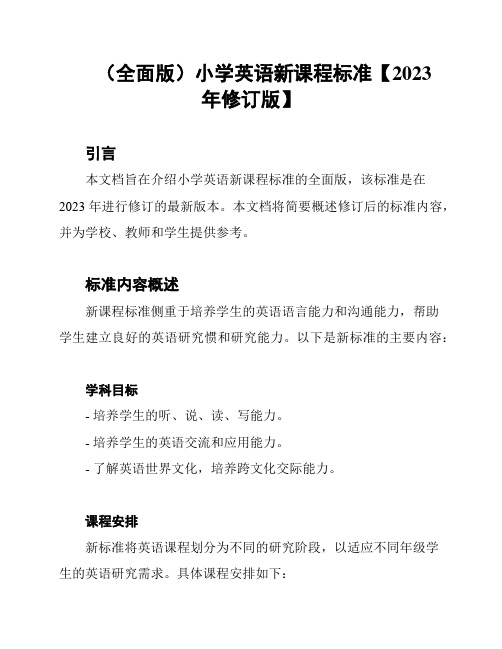
(全面版)小学英语新课程标准【2023
年修订版】
引言
本文档旨在介绍小学英语新课程标准的全面版,该标准是在2023年进行修订的最新版本。
本文档将简要概述修订后的标准内容,并为学校、教师和学生提供参考。
标准内容概述
新课程标准侧重于培养学生的英语语言能力和沟通能力,帮助
学生建立良好的英语研究惯和研究能力。
以下是新标准的主要内容:
学科目标
- 培养学生的听、说、读、写能力。
- 培养学生的英语交流和应用能力。
- 了解英语世界文化,培养跨文化交际能力。
课程安排
新标准将英语课程划分为不同的研究阶段,以适应不同年级学
生的英语研究需求。
具体课程安排如下:
- 小学一年级到三年级:重点培养学生的英语听和说能力,引
导学生进行简单的阅读和书写活动。
- 小学四年级到六年级:继续强化学生的听、说、读、写能力,扩展学生的词汇量和语法知识。
评价标准
新标准引入全新的评价机制,旨在全面评价学生的英语能力和
研究进步。
评价标准如下:
- 听力和口语评价:通过听力测试和口语表达评估学生的听说
能力。
- 阅读和写作评价:通过阅读测试和写作作品评估学生的阅读
和写作能力。
总结
新版小学英语课程标准旨在培养学生的英语语言能力和跨文化
交际能力。
学校和教师可以根据该标准制定教学计划,并使用合适
的评价方式进行学生的英语能力评估。
希望本文档能够为相关人员
提供有益的参考。
完整版)最新小学英语新课标试题整理版

完整版)最新小学英语新课标试题整理版2、1)关注学生的语言研究过程,注重培养学生的综合语言运用能力。
2)鼓励教师采用多种教学方法,注重培养学生的自主研究能力。
3)注重教学评价的多样性,充分考虑学生的实际表现和个体差异。
3、1)鼓励教师采用多种评价方法,注重学生的实际表现和个体差异。
2)强调评价的多样性,充分考虑学生的语言研究过程和综合能力。
3)注重评价结果的反馈,帮助学生及时调整研究策略和提高研究效果。
三综合题:英语课程标准提出了多种教学方法和途径,包括任务型教学、合作研究、情景教学等,强调教学过程的实践性和应用性。
在学生的语言研究和实践活动中,教师应该注重培养学生的语言运用能力,包括听、说、读、写和翻译等方面。
同时,教师应该鼓励学生采用多种研究策略,如记忆、理解、应用和评价等,帮助学生提高语言研究效果和综合能力。
此外,教师还应该注重学生的情感态度,如兴趣、动机、自信、意志和合作精神等,帮助学生积极参与语言研究活动,提高研究效果和综合能力。
1、优化评价方式,重点评估学生的综合语言运用能力。
2、丰富课程资源,扩展英语研究渠道,为每个学生奠定英语基础。
3、注重语言实践,培养学生的语言运用能力。
4、加强研究策略指导,提高学生的自主研究能力。
5、培养学生的跨文化交际意识和能力,以适应实际教学需要。
6、合理利用各种教学资源,提高学生的研究效率。
7、组织生动活泼的课外活动,拓展学生的研究渠道。
8、不断提高专业水平,适应课程要求。
9、充分发挥评价的积极导向作用,体现学生在评价中的主体地位。
10、根据课程目标要求确定评价内容与标准,注重评价方法的合理性和多样性。
11、形成性评价要有利于监控和促进教与学的过程,终结性评价要注重考查学生的综合语言运用能力。
12、注意处理好教学与评价的关系,小学的评价应以激励学生研究为主。
13、合理设计和实施初中毕业学业考试。
14、教师应创设接近实际生活的各种语境,采用循序渐进的语言实践活动,如任务型语言教学途径等,培养学生用英语做事情的能力。
2024最新高中英语新课程标准教育部部编版英文版

2024最新高中英语新课程标准教育部部编版英文版2024 New High School English Curriculum Standard Ministry of Education CompilationIn 2024, the Ministry of Education will implement a new high school English curriculum standard. This updated curriculum aims to enhance students' language skills and overall proficiency in English. The curriculum will focus on integrating various language components, such as reading, writing, listening, and speaking, to provide a comprehensive learning experience for students.The new curriculum will also incorporate modern teaching methodologies and resources to engage students effectively. It will emphasize practical language usage and real-life communication scenarios to help students apply their English skills in a practical context. Additionally, the curriculum will align with global English language standards to ensure that students are well-prepared for international communication and opportunities.Teachers will play a crucial role in implementing the new curriculum. They will be provided with training and support to facilitate effective teaching practices and student learning outcomes. The Ministry of Education will also provide updated teaching materials and resources to assist teachers in delivering the curriculum effectively.Overall, the 2024 new high school English curriculum standard by the Ministry of Education aims to elevate the quality of English education in high schools, equip students with essential language skills, and prepare them for future academic and professional endeavors.。
(完整版)高中英语课程标准_新课标_英文版
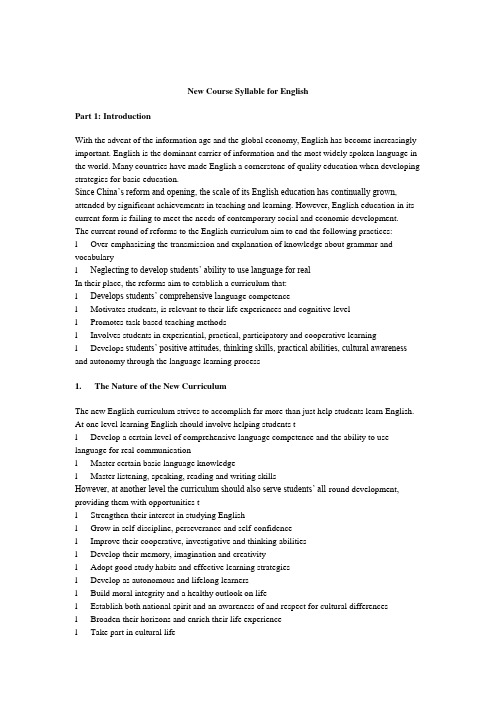
New Course Syllable for EnglishPart 1: IntroductionWith the advent of the information age and the global economy, English has become increasingly important. English is the dominant carrier of information and the most widely spoken language in the world. Many countries have made English a cornerstone of quality education when developing strategies for basic education.Since China’s reform and opening, the scale of its English education has continually grown, attended by significant achievements in teaching and learning. However, English education in its current form is failing to meet the needs of contemporary social and economic development.The current round of reforms to the English curriculum aim to end the following practices:l Over-emphasizing the transmission and explanation of knowledge about grammar and vocabularyl Neglecting to develop students’ ability to use language for realIn their place, the reforms aim to establish a curriculum that:l Develops students’ comprehensive l anguage competencel Motivates students, is relevant to their life experiences and cognitive levell Promotes task-based teaching methodsl Involves students in experiential, practical, participatory and cooperative learningl Develops students’ positive attitudes, thinking skills, practical abilities, cultural awareness and autonomy through the language learning process1. The Nature of the New CurriculumThe new English curriculum strives to accomplish far more than just help students learn English. At one level learning English should involve helping students tl Develop a certain level of comprehensive language competence and the ability to use language for real communicationl Master certain basic language knowledgel Master listening, speaking, reading and writing skillsHowever, at another level the curriculum should also serve students’ all-round development, providing them with opportunities tl Strengthen their interest in studying Englishl Grow in self-discipline, perseverance and self-confidencel Improve their cooperative, investigative and thinking abilitiesl Develop their memory, imagination and creativityl Adopt good study habits and effective learning strategiesl Develop as autonomous and lifelong learnersl Build moral integrity and a healthy outlook on lifel Establish both national spirit and an awareness of and respect for cultural differencesl Broaden their horizons and enrich their life experiencel Take part in cultural lifel Develop as individuals2. Basic Principles of the New Curriculum2.1The curriculum promotes quality education (as opposed to exam-orientated education) and the all-round development of the studentsTo promote quality education particular attention must be paid tl Valuing each student’s feelingsl Stimulating students’ interest in studying Englishl Helping students gain a sense of achievement and self-confidenceThe curriculum must go beyond developing students’ comprehensive language competence to include areas such as:l Improving students’ ability to contribute to cultural and social lifel Developing students’ practical abilitiesl Fostering students’ creativity2.2The curriculum objectives are holistic and flexible.The fundamental aim of the new English curriculum is to develop students’ comprehensive language competence. This aim is broken down into five general objectives. These objectives are then divided into nine ability levels with descriptors provided for each level. The five general objectives are:1. Language Skills2. Language Knowledge3. Attitudes to Learning4. Learning Strategies5. Cultural AwarenessThis design allows students to progress systematically through each level whilst meeting the full range of the curriculum’s demands.2.3Students are put at the centre of the curriculum and individual differences are respected Students’ must be at the heart of the new curricul um. For example, their developmental needs must be the central consideration when developing:l Curriculum objectivesl The teaching and learning processl The assessment processl Teaching and learning resourcesWhen implementing the curriculum each student must be allowed to develop individually under the guidance of the teacher:2.4The curriculum promotes activity-based methods, experiential and participatory learningThe curriculum promotes task-based learning whereby, under the guidance of the teacher, the students gain a sense of achievement by reaching the goals of the task. Task completion will involve the following types of learning:l Sensoryl Experientiall ‘Hands on’/practicall Participatoryl CooperativeIn order to improve their ability to use language for real communication, students should also be able tl Adjust their learning strategies and control their emotionsl Form positive attitudes towards learning2.5The curriculum recogni zes the important role of formative assessment in promoting student’ developmentThe assessment system should combine formative with summative assessment. The purposes of assessment should be tl Promote students’ comprehensive language competencel Encourage and motivate studentsl Help students become more autonomous learnersl Benefit students’ healthy personal developmentl Give teachers useful feedback from which to develop teaching and learningl Inform the ongoing development and perfection of the English curriculumFormative assessment should be an important part of the English teaching and learning process with a particular emphasis on:l Encouraging students’ active participation in learningl Improving stu dents’ self-confidenceSummative assessment should focus on:l Testing students’ integrated language skillsl Testing students’ ability to use language2.6The curriculum expands the range of learning resources and opportunities availableThe curriculum should strive to use and develop resources whose content is:l Realisticl Close to the students’ livesl Contemporaryl Healthyl Rich and variedActive use should be made of:l Audio visual materiall Print medial The InternetStudents should be encouraged to take responsibility for finding, using and developing learning resources themselves.3. The Curriculum DesignThe curriculum follows the international practice of dividing the general objectives into different ability levels. When designing these nine levels consideration was given to the following:l The nature of language developmentl The different needs of different age groupsl The needs of different ethnic groups and areasl The economic imbalances that exist in ChinaThe aim is to have designed a system that is holistic and flexible.The correspondence between the level system and the grade system is shown in the following diagram:。
- 1、下载文档前请自行甄别文档内容的完整性,平台不提供额外的编辑、内容补充、找答案等附加服务。
- 2、"仅部分预览"的文档,不可在线预览部分如存在完整性等问题,可反馈申请退款(可完整预览的文档不适用该条件!)。
- 3、如文档侵犯您的权益,请联系客服反馈,我们会尽快为您处理(人工客服工作时间:9:00-18:30)。
初中英语新课程标准试题(一)一、填空题1.外语是基础教育阶段的必修课程,英语是外语课程中的主要语种之一。
2.《英语课程标准》第二级为六年级结束时应达到的基本要求;第五级为九年级结束时应达到的基本要求;第八级为高中毕业的基本要求。
3.《英语课程标准》将课程目标设定为九个级别并以学生“能够做某事”具体描述各级别的要求,这中设计旨在体现基础教育阶段能力发展循序渐进的过程和课程要求的有机衔接,保证国家英语课程标准的整体性、灵活性和开放性。
4.建立能激励学生学习兴趣和自主学习能力发展的评价体系。
该评价体系由形成性评价和终结性评价构成。
在英语教学过程中应以形成性评价为主,注重培养和激发学生学习的积极性和自信心。
终结性评价应着重检测学生综合语言技能和语言应用能力。
—9年级和普通高中的英语课程建议每周不少于四课时。
6. 听力测试在学期、学年和结业考试中所占比例应不少于20%。
笔试应避免单纯语音知识题和单纯语法知识题;增加具有语境的应用型试题;适当减少客观题、增加主观题。
7.基础教育阶段英语课程的总体目标是培养学生的综合语言应用能力。
8、基础教育阶段学生应该学习和掌握的英语语言基础包括语音、词汇、语法、功能和话题等五个方面的内容。
9、《全日制义务教育英语课程标准》中的情感态度是指兴趣、动机、自信、意志和合作等影响学生学习过程和学习效果的相关因素。
10、三维学习目标指知识与技能、过程与方法以及情感态度与价值观、11、外语是基础教育阶段的必修课程,英语是外语课程中的主要语种之一。
12、基础教育阶段英语课程的任务是:激发和培养学生学习英语的_兴趣,使学生树立自信心,养成良好的学习习惯和形成有效的学习策略,发展自主学习的能力和合作精神;使学生掌握一定的英语基础知识和听、说、读、写技能,形成一定的综合语言运用能力;培养学生的观察、记忆、思维、想象能力和创新精神;帮助学生了解世界和中西方文化的差异,拓展视野,培养爱国主义精神,形成健康的人生观,为他们的终身学习和发展打下良好的基础。
13、《全日制义务教育英语课程标准》,将课程目标设定为九个级别,并以学生“能够做某事”具体描述各级别的要求,这种设计旨在体现基础教育阶段学生能力发展循序渐进的过程和课程要求的有机衔接,保证国家英语课程标准的整体性、灵活性和开放性。
14、国家英语课程要求从三年级起开设英语课程。
《标准》第二级为六年级结束时应达到的基本要求;第五级为9年级结束时应达到的基本要求;第八级为高中毕业的基本要求。
第三、四、六、七级为第二、五、八级之间的过渡级。
15、基础教育阶段英语课程的总体目标是培养学生的综合语言运用能力。
综合语言运用能力的形成建立在学生语言技能,语言知识,情感态度,学习策略和文化意识等素养整体发展的基础上。
语言知识和语言技能是综合语言运用能力的基础,文化意识是得体运用语言的保证。
情感态度是影响学生学习和发展的重要因素,学习策略是提高学习效率、发展自主学习能力的保证。
16、语言技能包括听、说、读、写四个方面的技能以及这四种技能的综合运用能力。
听和读是理解的技能,说和写是表达的技能;这四种技能在语言学习和交际中相辅相成、相互促进。
17、基础教育阶段学生应该学习和掌握的英语语言基础知识包括语音,词汇,语法,功能,话题等五方面的内容。
知识是语言能力的有机组成部分,是发展语言技能的重要基础。
18、《全日制义务教育英语课程标准》中的情感态度是指兴趣,动机,自信,意志,合作等影响学生学习过程和学习效果的相关因素。
19、小学阶段听、说、读、写语言技能之间的关系如下:听是分辨和理解话语的能力;说是运用口语表达思想,输出信息的能力;读是辨认和理解书面语言,即辨认文字符号并将文字符号转换为有意义的信息输入的能力;写是运用书面表达思想,输出信息的能力。
20、为保证教学质量和教学效果,3~6年级英语课程应遵循_长短课时结合、高频率原则,每周不少于四次教学活动,3、4年级以短课时为主,5、6年级长短课时结合,长课时不低于2课时。
班容量一般不超过40人/班。
7~9年级和普通高中的英语课程建议每周不少于 4课时。
21、听力测试在学期、学年和结业考试中所占比例应不少于20%。
笔试应避免单纯语音知识题和单纯语法知识题;增加具有语境的应用型试题;适当减少客观题、增加主观题。
22、语言技能一级目标:能唱英语儿童歌曲15一20首,说歌谣15一20首,视听时间每学年不少于10小时(平均每周20~25分钟)。
语言技能二级目标:能表演歌谣或简单的诗歌30一40首(含一级要求),能演唱英文歌曲30一40首含一级要求),能看懂英文动画片和程度相当的英语教学节目,每学年不少于10小时(平均每周不少于20~25分钟)。
23、语言技能三级目标:除教材外,课外阅读量达到4万词以上。
语言技能四级目标:除教材外,课外阅读量应累计达到10万词以上。
语言技能五级目标:除教材外,课外阅读量应累计达到15万词以上。
24、语言知识二级目标:学习有关本级话题范围的600~700个单词和50个左右的习惯用语。
语言知识五级目标:学习使用1500~1600个单词和200~300个习惯用语和固定搭配。
语言知识八级目标:学会使用3000个单词和400-500个习惯用语或固定搭配。
25、义务教育阶段的英语课程具有工具性和人文性双重性质。
26、英语课程总目标是以语言技能、语言知识、情感态度、学习策略、文化意识等五个方共同构成的。
27、重视英语教学中语言的工具性和实用性。
28、自觉实践法的教学原则有交际性、自觉性、直观性、功能—情景性、口语领先29、正确地开展课外活动应该有利于“师生之间建立起一种超越课堂教育范围的纽带”,有利于激发学生学习外语的积极性,有利于增加外语实践的机会。
30、教师在开展课外活动中扮演的角色有激发者角色、观察者角色、咨询者角色。
31、日常教学之余可以组织的课外活动形式有短剧表演、英语读书报告会、英语角活动、英语晚会、组织各种竞赛活动。
32、学生的经验是一种课程资源,它包括学生已有的知识水平、认知结构和社会阅历等,是我们教学的起点,因为新知识的获取必须以学生已有的经验为基础。
33、文化意识教学应遵循的原则:尊重、平等的原则,真实、实用原则,兴致、趣味原则,实践、互动原则,比较、融合原则。
二、判断题:对正确的陈述,在括号里写t,对错误的陈述在括号里写f.(10分)1、"面向全体学生,为全面发展和终身发展奠定基础"是本次基础改革的核心思想。
(正确)2、基础英语语言知识是综合运用能力的有机组成部分。
(正确)3、评价的内涵得到极大扩充,评价等于考试,考试是评价的唯一手段。
(错误 )4、任何一门现存的自然语言都包含有丰富的文化内涵,而且,从小至单个的词到大至语篇的各个层面都体现出文化内涵。
(正确)5、提倡探究式学习是排除语言知识的学习,只是改变了的方式和途径。
(错误)6、听和读是由内部语言转换为外部语言;说和写是由外部语言转换成内部语言。
(错误 )7、少年儿童具有成年人不可比拟的语言优势。
(正确)8、我们提倡对的个人发展和全面素质以及他们掌握的语言知识进行评价。
(正确)9、评价就是指考试。
(错误)10、考试成绩统计常常要做的是通过计算集中趋势,了解考生的典型的或是普遍的应试表现。
平均数是计算集中趋势最常用的方法。
(正确)11、“面向全体学生,为学生全面发展和终身发展奠定基础”是本次基础教育改革的核心思想。
(√)12、英语学习策略是学习者在学习过程中处理具体问题的技术或技巧,类似于足球中的技术(×)13、评价的内涵得到极大扩充,评价等于考试,考试是评价的唯一手段。
(×)14、任何一门现存的自然语言都包含有丰富的文化内涵,而且从小至单个的词到大至语篇的各个层面都体现出文化内涵。
(√)15、探究学习的本质是学生基于自身的兴趣,在教师的指导下,学生通过自己的努力和亲身的体验,主动获取知识或信息,应用知识或信息在解决问题,完成交际任务,有的情况学生可以自己确定专题。
(√)16、在任务型学习活动中教师不但应该是课堂交际活动的参与者,还应该充当学生的“活字典”、“资料库”,从教师的职责出发,观察、监控课活动的进展。
(√)17、评价的内涵得到极大扩充,评价等于考试,考试是评价的唯一手段。
(√)18、少年儿童具有成年人不可比拟的语言学习优势。
(×)三、单选与多选多项选择题(12分)1、英语课程标准的基本观念是什么(a b cd e f)A、面向全体学生,注重素质教育。
B、整体设计目标,体现灵活开放。
C、突出学生主体,尊重个体差异。
D、采用灵活途径,倡导体验参与。
E、注重过程评价,促进学生发展。
F、开发课程资源,拓展学用渠道。
2、下面几项哪些是二级课程总体目标的描述(b c d e f)A、对英语有好奇心,喜欢听他人说英语。
根据教师的简单指令做游戏、做动作、做事情(如涂颜色、连线)。
B、在学习中乐于参与、积极合作、主动请教。
乐于了解异国文化、习俗。
C、能用简单的英语互致问候、交换有关个人、家庭和朋友的简单信息。
D、能根据所学内容表演小对话和歌谣。
E、能在图片的帮助下听懂、读懂简单的故事、并讲述简单的故事。
F、能根据图片或提示写简单的句子。
3、为什么要把情感态度列为英语课程目标之一(a b c d)A、语言与情感态度有密切关系;B、情感态度对语言学习的结果有重要影响;C、情感态度本身就是学生全面发展的一个重要方面;D、关注情感态度是国际基础教育改革趋势的重要特征之一。
4、如何在英语教学中培养和发展学生积极的情感态度(a b c d )A、建立良好的师生关系B、建立情感态度的沟通和相互交流的渠道。
C、结合外语学习内容讨论有关情感态度的问题。
D、帮助学生克服情感态度方面的困难。
5、任务驱动型学习活动的目的是(a b c )A、学习人际交流,用所学语言与他人交流信息,交换意见,沟通感情,建立和维持某种人际关系。
B、学习从社会媒体获取用语言传播的信息,并付之应用。
C、学习欣赏与所学语言水平相当,但语汇有所扩展的作品,如故事、诗歌、歌曲、戏剧等,并能对其作出反响,甚至自己进行创作。
6、以下几点,哪些能体现教师工作方式的变化(a b c d)A、新课程标准如何得到家长的理解。
B、新的教学思想和教学方案如何得到校长的支持。
C、教师与学生的合作,同科教师之间的资源共享。
D、跨学科教师之间沟通,相互交流的灵感启迪。
单选1、下列各项中不是英语教材的编写体现的原则是( D )。
A、思想性原则B、科学性原则C、趣味性原则D、直观性原则。
2、下列选项中不是英语课程评价的功能的是( C )A、导向功能B、反馈功能C、启发功能D、促进功能3、下列选项中不属于形成性评价应注意的原则的是( B )。
